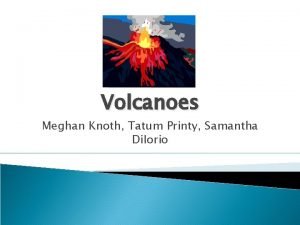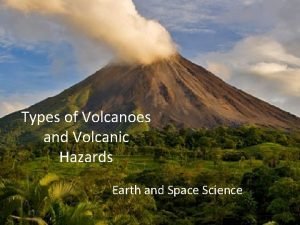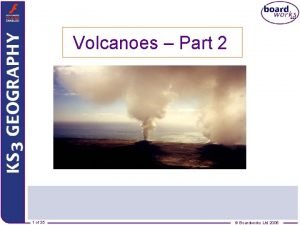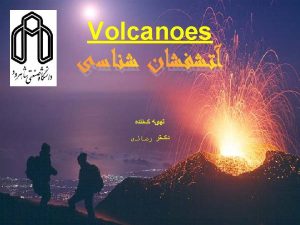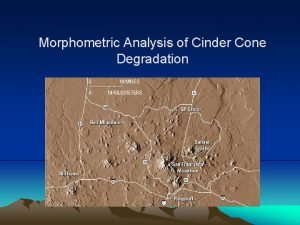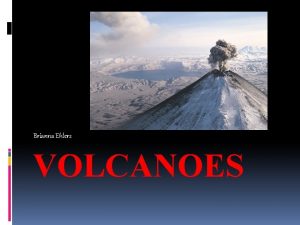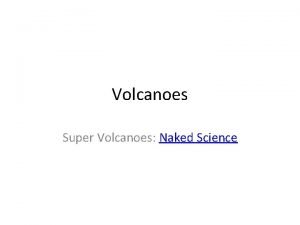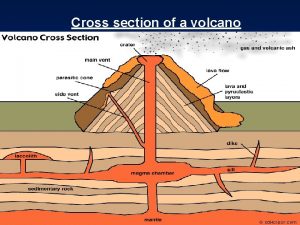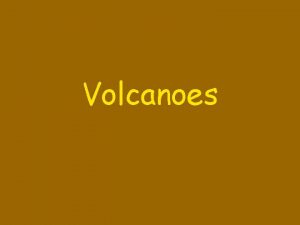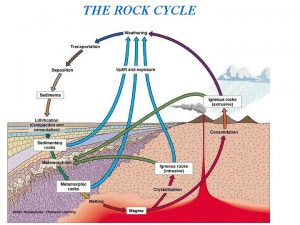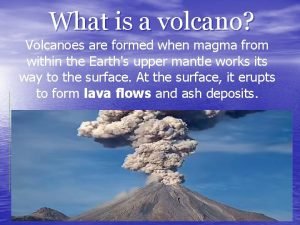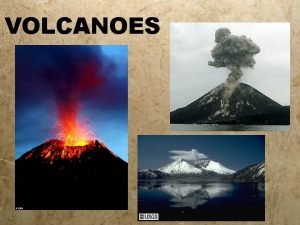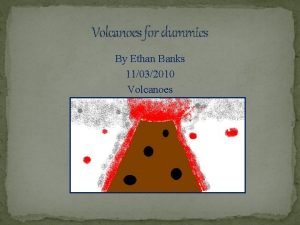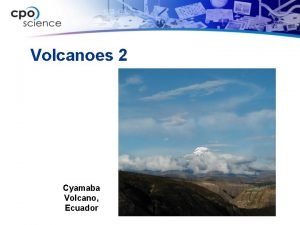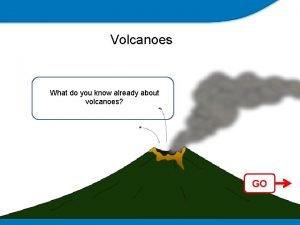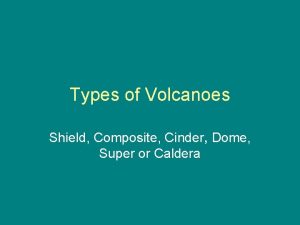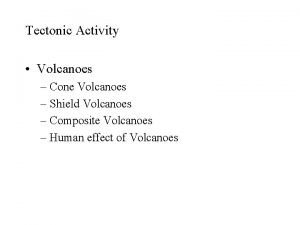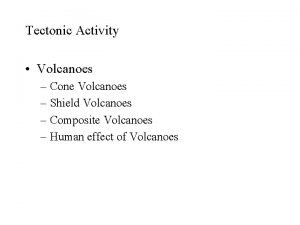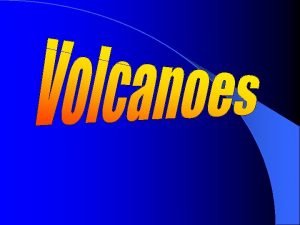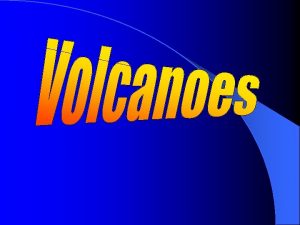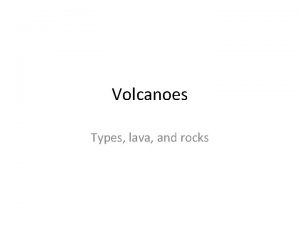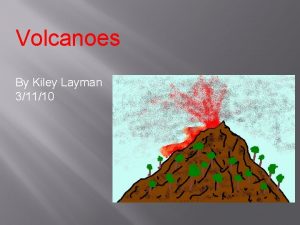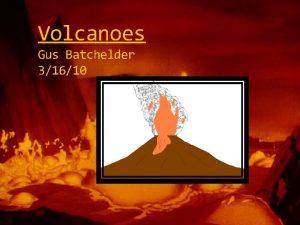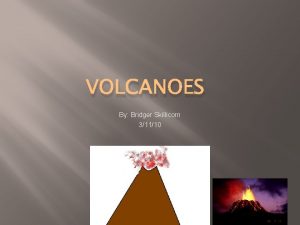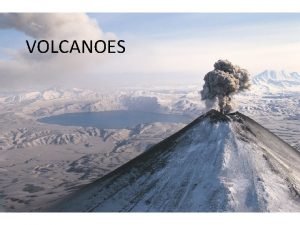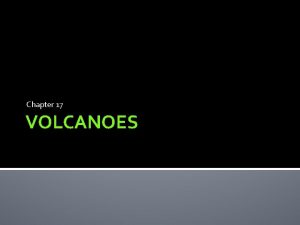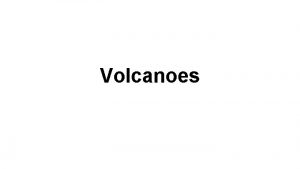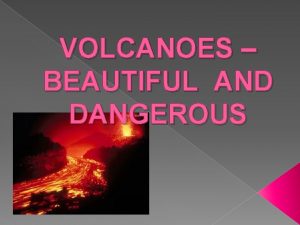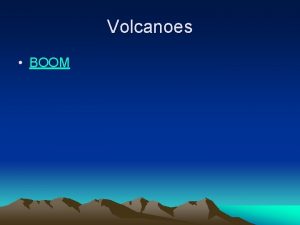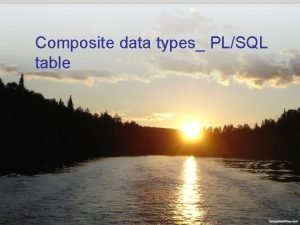Types of Volcanoes Shield Composite Cinder Dome Super

























- Slides: 25

Types of Volcanoes Shield, Composite, Cinder, Dome, Super or Caldera

Shield Volcanoes • Hawaii, Iceland, Galapagos Islands • Made almost entirely from fluid lava flows • Basaltic lava, generally non-explosive due to low silica content • Gently sloping sides, sometimes kilometres wide http: //wapi. isu. edu/Env. Geo/EG 6_volcano/volcanoes. htm

Mauna Loa is the largest of the shield volcanoes (and also the world's largest active volcano). It projects 4170 m above sea level- its top is over 9000 m above the deep ocean floor. • http: //vulcan. wr. usgs. gov/Glossary/Shield. Volcano/description_shield_volcano. html

Strato or Composite Volcanoes • Alternating layers of lava and ash • Magma is too thick to let gasses escape, so typically explosions are violent, and characterized by pyroclastic blasts

Mount Fuji • http: //www. britannica. com/EBchecked/topic-art/394808/71635/Mount-Fuji-Japan

Stratovolcanoes • • Steep sides, symmetrical Usually a crater at the top Can be quite large Alternating layers of lava, and ash, cinders, blocks and bombs • Usually obvious – and beautiful • Associated with SUBDUCTION zones

Mount Cotopaxi, Ecuador • Mount Rainer, Washington • Mount St. Helens, Washington • http: //www. cnsm. csulb. edu/departments/geology/people/bperry/geology 303 /geol 303 text. html

Cinder Cones • Built from small ribbons or blobs of congealed lava • Gas-charged lava is blasted into the air • Breaks up and lands on the sides of the volcano • Lava cools in the air • Form a cone or oval shaped volcano that cannot rise more than about 1000 metres because the volcano is not stable

A cinder cone inside the caldera of a stratovolcano at Crater Lake, Oregon

Cinder cone at Little Lake, Ca http: //www. educ. uvic. ca/faculty/mroth/438/VOLCANO/cinder. html


“Pu'u ka Pele is a lovely cinder cone sitting on the flank of Mauna Kea volcano, Hawaii. Cinder cones are piles of volcanic ash that build up around explosive vents, usually on the side of larger volcanoes. They're so loose that lava doesn't build up inside to flow out of the top. Instead, lava flows break out the side. ” http: //geology. about. com/library/bl/images/blcindercone. htm Sold as lava rock for landscaping, but actually called scoria

Dome Volcanoes • Lava too viscous (thick) to flow far • Lava piles up around the vent • Domes sometimes develop inside the craters of composite volcanoes Largest dome volcano – Lassen Peak California http: //lassenpeak. wordpress. com/2008/04/03/about/

Fissure Volcanoes • No central crater • Lava flows out of cracks or fissures in the earth • Laki, Iceland http: //whatonearth. olehnielsen. dk/volcanoes. asp http: //marsoweb. nasa. gov/Hi. RISE/science_themes/volcanology. html

Plateau or Flood Basalts • Many layers of basalt lava • Can be kilometres thick and cover 100 s of m² of territory • Deccan Traps, India – May have caused extinction of the dinosaurs due to sulphuric gasses • Columbia Plateau http: //geology. about. com/library/bl/tours/blfoto_cascades 8. htm http: //earthsciences. syr. edu/Grad. Info/ESGrad. Students/Dasgupta. html

http: //shastatrails. com/images/basalt/map_columbia_river_flood_basalts. gif

Super Volcanoes – sometimes called caldera volcanoes • Exceedingly large, catastrophic volcanic events • Yellowstone – 3 in the past 2. 1 million years • Toba, Indonesia – 75 000 years ago – possibly the largest in 25 million years

Yellowstone National Park

Other features, issues

Lahar • Torrential mudflows of wet volcanic debris • Created when – a pyroclastic flow meets a snow bank or glacier which is then melted by the hot volcanic debris – a crater lake wall collapses – Rain water or river transforms new ash deposits into mudflows

An explosive eruption on March 19, 1982, sent pumice and ash 14 km into the air, and resulted in a lahar Mt. St. Helens

“This is a picture of a cold lahar, which happened after an earthquake near the Colombian volcano Nevado del Huila in 1994. The Rio Paez, flowing across the bottom of the image, filled with black muck and overran several towns along the river. Smaller slides like those in the image joined it, turning it into what survivors called a black wave of death. ” http: //geology. about. com/library/bl/images/bllahar. htm

Caldera • Caldera or crater created by a catastrophic explosion which causes the top of the volcano to collapse • Can be 25 km across • This is Crater Lake, Oregon

Types of Lava • Basaltic lava -flows readily and travels far – Shield volcanoes – Plateau or Flood Basalts • Andesitic – in between – not as fast as Basalt, not as slow as Rhyolitic – Characteristically found in composite volcanoes • Rhyolitic lava - can just barely flow; produce a volcanic dome that eventually is destroyed in a massive explosion as the viscous lava tries to escape

http: //pubs. usgs. gov/of/2004/1007/volcanic. html
 Shield volcanoes
Shield volcanoes Lithosphere definition
Lithosphere definition Types of volcanoes
Types of volcanoes Types of volcanoes according to shape
Types of volcanoes according to shape Types of volcanoes
Types of volcanoes Super long
Super long Cinder cone def
Cinder cone def Cinder summary
Cinder summary Cinder cone def
Cinder cone def Ash and cinder cone
Ash and cinder cone Cinder retype
Cinder retype What is a mountain
What is a mountain Cross section of a cinder cone volcano
Cross section of a cinder cone volcano Nvmetcli
Nvmetcli Cinderfit
Cinderfit Cinder availability zone
Cinder availability zone Cinder
Cinder Cinder cone
Cinder cone Cinder cone
Cinder cone Moment of inertia beam
Moment of inertia beam Crust volcano
Crust volcano How are volcanoes classified
How are volcanoes classified Volcanoes for dummies
Volcanoes for dummies Ecuador
Ecuador How are volcanoes made
How are volcanoes made What do you already know about volcanoes
What do you already know about volcanoes
